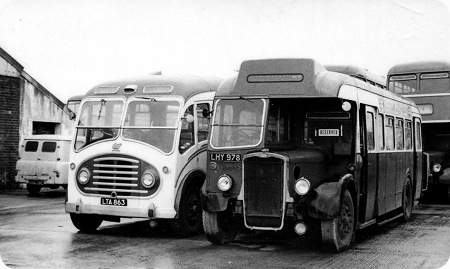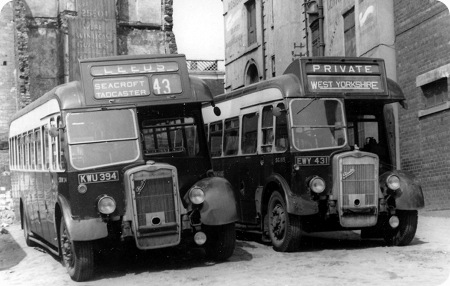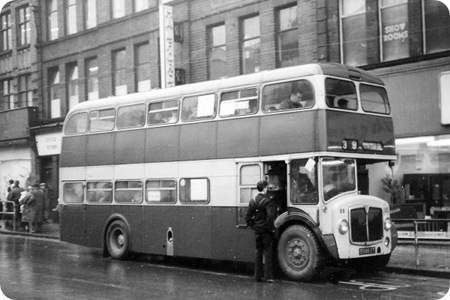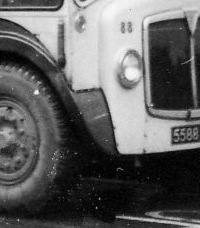Bristol Omnibus – Bristol L6B – LHY 978 – C2738

Photograph by ‘unknown’ if you took this photo please go to the copyright page.
Bristol Omnibus
1949
Bristol L6B
ECW B33D
This photo was on the ‘Do you Know’ page, but thanks to Spencer for the information that led to this article.
Here we have two Bristol Single deckers from two different operators for sale at W Norths Limited, Sherburn-in-Elmet a dealer near York and the photo was taken in March 1966.
The one on the right is as the above specification, the interesting thing about this bus is the dual doors one at the front and one at the rear. I presume the bus had been converted to one man operation and the policy was you got on at the front and off at the rear. Looking at the doors though they appear to be manually operated so last on or off had to close the door. I bet there has been a fair bit of ‘tutting’ done on this bus in its lifetime due to people not closing the doors. If I am incorrect with my presumption please correct me by leaving a comment.
The one on the left is a Western National Omnibus 1951 Bristol LWL6B with an ECW C37F body registration LTA 863 fleet no 1314. A full fronted coach, but there was no need rushing to get on the bus first so you sit at the front next to the driver, no seat, just engine and wheel arch.
By the way, both of these buses were bought from the dealer, the one on the right went to contractor in Otley Yorkshire as a staff bus, not sure how long for though. The one on the left went on to Jordan Motor Services Limited, Blaenavon and did a further four years service before being scrapped in 1970.
A full list of Bristol codes can be seen at this link.
Yes this coach along with 9 others of this type were later owned by Jordans Blaenavon the last of these were I believe all were scrapped by 1971 the others came from Bristol Greyhound.
Tony
The twin door ECW bodied L types were unique to Bristol City services. They were always conductor operated. The front door was (after the first few years at least), automatic and operated by the driver. {As a schoolboy I used to always get off at the front just to be annoying – a lot of the drivers would forget to open the door.} In about 1958 there was a major re-organisation of services in Bristol which resulted in almost all becoming double deck operated and all of these L types were taken off. The 1947 series (JHT registrations) were disposed of. The LHY and MHW registered batches were exchanged for 35 seat rear door country fleet ones. Some were converted to one man operation with the rear door removed. A few, including the one in the picture, continued to operate in the country area as twin door buses.
Peter Cook
08/08/12 – 07:17
Having just been looking at this picture again, and having been doing CPC part of last week to keep my PCV license up, I have just realised that it would actually be illegal to operate the dual door L type without a conductor.
Peter Cook
17/12/14 – 05:38
I also travelled on B33D L types to games afternoons when at school. They ran, I think, service 145 from Horsefair which started off up St Michael’s Hill – quite exciting!
Previous comment is right. The redundant City vehicles were swopped for single door country buses and the company then converted the two door versions quite easily into one man operated, by extending the cab with a diagonal window across the engine bay, using the existing (slow) power sliding door and panelling in the rear door and upseating to 35. Like many operators one man operation took many Tilling operators by surprise!
Geoff Pullin
20/12/14 – 06:30
I don’t remember the 145 as a single deck route as my regular journeys to school in central Bristol began in 1958. The Ls were used on service 17 Temple Meads – Clifton, 139 Stapleton and 239 Ashton Vale (these two having low bridges and later combined as the 19).
Geoff Kerr
25/08/19 – 07:29
I have a print of the above photo and it is endorsed copyright Trevor Hartley and is dated 12 APR 1966.
Hope this helps to solve the photographer ‘unknown’ part of the description.
Ian Mawson
27/08/19 – 05:23
I can confirm that I took this photo at Norths on 12 April 1966. I am delighted that it provides interest and pleasure 50+ years on.
Trevor Hartley




